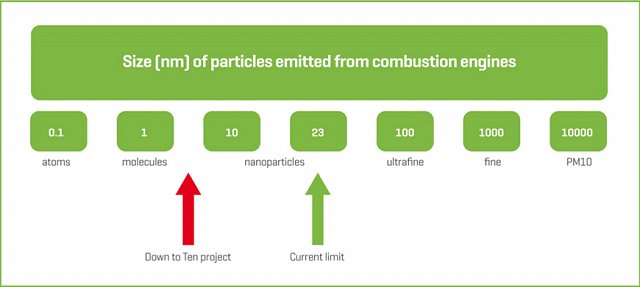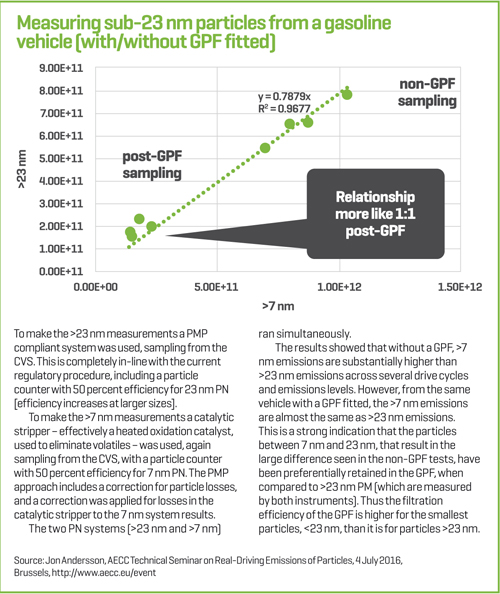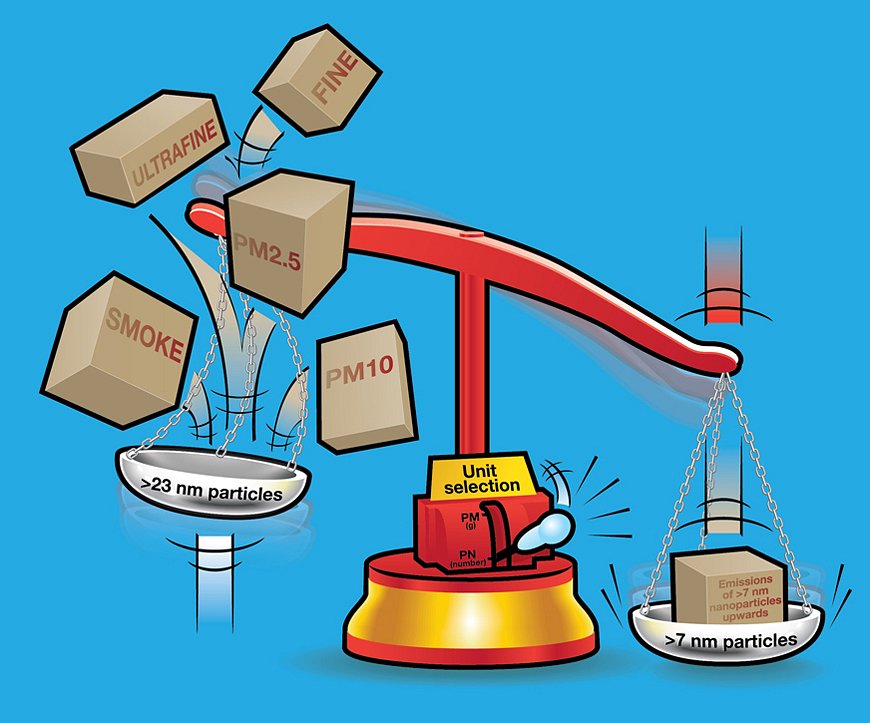Improving urban air quality is the major impetus for a continuing push towards monitoring and regulating particle emissions. Now attention is extending to include particles significantly below the threshold of current regulation, approaching the molecular range – and Ricardo is spearheading some of the latest research in this area as well as helping industry comply with existing and future regulation.
In the continuing endeavour to control harmful emissions from motor vehicles, the measurement of particle numbers (PN) is now firmly a part of the European regulatory framework. The introduction of PN standards followed the pioneering work carried out by Ricardo and its partners in the early 2000s under the then UN-ECE GRPE (United Nations Economic Commission for Europe Groupe des Rapporteurs pour la Pollution et l’Energie) Particle Measurement Programme (PMP), an organization later brought under the auspices of the European Commission.
This ground-breaking initiative moved the application of particle emission control science on: as well as measuring the mass of particles, the approach was expanded to include the monitoring of individual particles.
Regulations now prescribe that in addition to meeting the previous mass-based requirement, new vehicles must also emit fewer than 6E11 particles per kilometre over the standard homologation drive cycle (currently NEDC, but to be replaced with the WLTC later in the year). This particle number limit is based on PN measurement above a (non-volatile) particle size threshold of approximately 23 nm. This limit was established both in terms of what was practical to achieve accurately and in a repeatable manner at the time, as well as representing the approximate primary particle size of soot or black carbon emitted as a result of incomplete combustion.
While PN measurement technology for automotive applications remains comparatively new, the particle number limit is also included in the Real Driving Emissions (RDE) element of the WLTP, meaning that the first generation of vehicle-based measurement systems must be PN capable.
While this is leading to a significant effort at supporting the roll-out of PN-based RDE, the very latest studies by Ricardo and its research partners are pushing even further, aiming to resolve particles of a size only marginally greater than the molecular level.

Size rather than mass matters
The need to improve urban air quality is the major impetus for continuing the push towards monitoring and regulating particle emissions down to circa 10 nm, explains Jon Andersson, Ricardo global technical expert for emissions measurement and standards: “There is a growing body of settled scientific opinion that the negative health effects associated with particulate emissions are more closely correlated with either the number of particles or the total surface area of particles, rather than with the overall mass emitted.”
There are in effect two reasons for this. Firstly, for a given mass of particulate emission, a much larger surface area will be available with a greater number of smaller particles than with fewer larger ones. As the particle surface is effectively the transport medium for other compounds generated by, or surviving, combustion, it is not just the particle that can be ingested, but what it carries too. A larger surface area – albeit spread over a greater number of smaller particles – therefore means an increased likelihood of these compounds being ingested.
Secondly, as Andersson explains, while the human respiratory system has evolved to deal with larger particles such as dust or pollens, it is not so well equipped to deal with much smaller ultrafine and nanoparticles. “Nanoparticles can enter the bloodstream directly during respiration through a process of translocation. These circumvent the body’s normal defensive barriers and, once in the circulatory system, they can collect in vital organs such as the brain or liver. There are a whole host of negative health effects that are now being postulated as being attributable to these nanoparticle emissions.”
With the original work of the PMP a decade ago it was recognized that as the recorded mass of particulate emissions goes up, the number might go up too – but that the two do not necessarily always correlate. Number-based metrics were therefore recognized as being far more likely to effectively target the emissions that are most damaging to health.
Gasoline is the future focus for nanoparticles
The original PMP work that led to today’s PN regulations has to a large degree solved the issue of particle emissions from modern diesel engines. While some light duty diesels might have achieved the particle mass requirement without aftertreatment, DPF fitment would be required for all engines to achieve the required PN standard. From Euro 5 onwards, all European light duty diesel vehicles have thus been DPF equipped and, if appropriately calibrated, can generally comfortably also be made to conform to RDE regulations for particle emissions. It is also thought that current DPF technology is good at capturing particles below the existing 23 nm threshold, as the presence of soot already captured within the DPF appears to be a highly effective filter in its own right, substantially exceeding the filtration efficiency of the substrate.
The latest generation of gasoline powered vehicles may be able to meet the existing 23 nm target without applying particle aftertreatment in the form of a gasoline particulate filter (GPF). To investigate the level of sub-23 nm particles emitted by a typical gasoline powered car, however, Andersson and his team have worked with industry body AECC (the Association for Emissions Control by Catalyst) on a project in which RDE measurements of gases and PN were first recorded on the road. These RDE measurements were then reproduced and modified in the vehicle test laboratory where they could be stressed, for example by increasing the dyno load and reducing temperature, and highly accurate PN measurements taken both with and without a GPF fitted.
“We carried out two sets of vehicle measurements,” explains Andersson. “The first was on the current regulatory level of particles greater than 23 nm, with a second data set measured at 7 nm and upwards. The difference between these two tells us how many smaller particles are being emitted in the size range between 7 nm and the 23 nm lower threshold of current regulations.”
“What we have been able to see is that the GPF tested is more efficient for the smaller particles than for the larger ones. While at first sight that may sound counter-intuitive, there is nevertheless a clear technical logic to it. The smaller particles effectively behave much more like a gas, so they diffuse into the structure of the filter much more quickly than the larger particles. So the GPF gives very effective filtering at this smaller particle size band, even with a filter that is relatively empty of soot.”
GPFs work in a similar manner to DPFs. However, there is much less soot mass in the emissions of a gasoline engine, so the amount to be trapped is much smaller. Also, as a gasoline engine has a lean episode every time there is a fuel shut-off, the temperature spike at these frequently occurring conditions is sufficient to trigger soot combustion. As such, soot almost never accumulates in a GPF in the manner that it does in a DPF, and there is no requirement for any form of active regeneration strategy for normal driving.

The results of this work clearly demonstrated that while the test vehicle satisfies current particle emission regulations, it frequently exceeded the 6E11 particles per km limit on tests in which the size range of measurement started from 7 nm, demonstrating just how numerous these smaller nanoparticles can be. Conversely with a GPF fitted, the vehicle emitted less than the 6E11 particles per kilometre limit for all tests, effectively controlling both the current regulatory size range and the <23 nm particles too.
New engine technologies, new challenges
As automakers push to make the gasoline engine ever more efficient, regulators are becoming concerned about this smallest size range of nanoparticles because of a fundamental change in the way that non-combustible compounds are emitted.
As engine-out soot levels are reduced as a result of more efficient combustion, the resulting particle emission is generally comprised of smaller agglomerates within an approximately identical number of particles. Soot agglomerates of perhaps up to 80-100 nm in size will include compounds such as metal oxides that arise from the non-combustible components of the fuel and lubricant additive packs, and engine wear. These compounds of elements such as zinc, phosphorous and calcium have always and may appear as particles smaller than 10 nm, but they effectively attach to the surface of abundant larger soot agglomerates. The concern with future high-efficiency gasoline combustion is that the inherent lack of soot particle agglomerates in the emissions will result in much larger numbers of independent metal oxide and other near 10 nm particles being emitted.
How low to go?
With widespread and increasing concern over the health consequences of nanoparticle emissions, the European Commission is already supporting further research by Ricardo and other researchers, including the PMP group, into measurement technologies, systems and methodologies that might support a lowering of the current particle number threshold.
Three Horizon 2020 projects are currently being supported in the area of examining how particle numbers can be reliably counted in a repeatable manner below the current 23 nm threshold of regulation. Reflecting the high priority attached to this area of research, the new engine technology projects also being funded under the auspices of the Horizon 2020 programme are to be evaluated at sub-23 nm particle emission levels using the new approaches developed in the particle research projects.
Ricardo is an active participant in the three-year ‘Down To Ten’ project, the main thrust of which is to consider the application of both condensation particle counter and diffusion charger methods of particle counting. Following thermal or catalytic processes by which volatile particles are removed, a condensation particle counting method is used for the current regulatory testing approach. This is based on artificial growth of non-volatile particles by mixing them with a supersaturated butanol vapour and then cooling the mixture. The tiny nanoparticles become nucleation centres for droplet formation and grow to spheres of a size where laser counting is possible.
By contrast, diffusion chargers are based upon the transfer of an electric charge to the surface of the particles, followed by the measurement of charge transferred at an electrometer over which the exhaust is passed. Effectively this approach is an indirect counting method, and tends to be less sensitive than counting the particles. It has advantages too, however, as it is a more practical approach for the type of OBD measurement system that might eventually form part of the production vehicles’ monitoring systems.
“It’s important that we can explore both of these measurement technologies in Down To Ten,” explains Andersson, “as there is clearly an overlap of requirements between the test laboratory, RDE, and through-life vehicle OBD-based compliance monitoring. The outcome of the current horizontal Horizon 2020 projects looking into this subject should provide a thorough basis on which regulators can make decisions regarding any future lowering of the current 23 nm particle threshold – including just how low the new limit needs to be – as well as the measurement systems and methodology that will be needed to ensure that the limit can be enforced.”
Work on the Down To Ten project has only just started, but it builds upon previous efforts by Ricardo and the PMP team examining sub-23 nm particle emissions, as well as the 15 or so years of research that led to the original regulatory regime that has been so effective in reducing the particle emissions of modern diesel engines. With the proactive approach being adopted by the European Commission, a modified framework may well be in place to address the nanoparticle emissions of next-generation high-efficiency gasoline engines as these become an increasingly important part of the powertrain picture.
This article is an edited version of a feature published in RQ magazine, Q1, 2017 - click on the magazine cover below to go to the magazine version:


